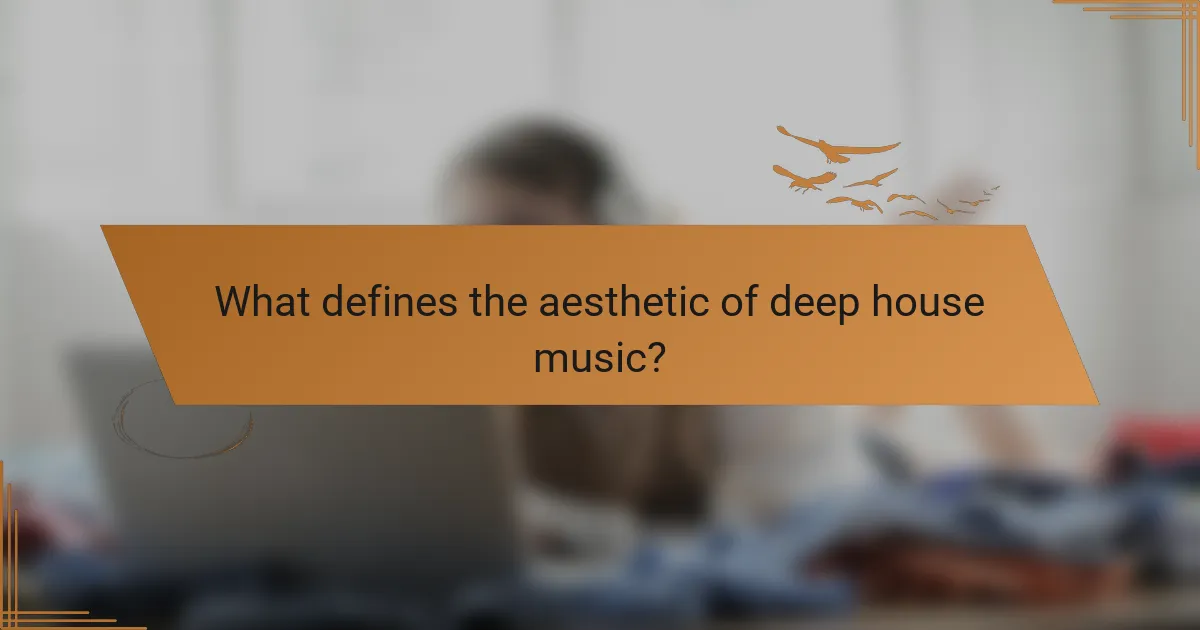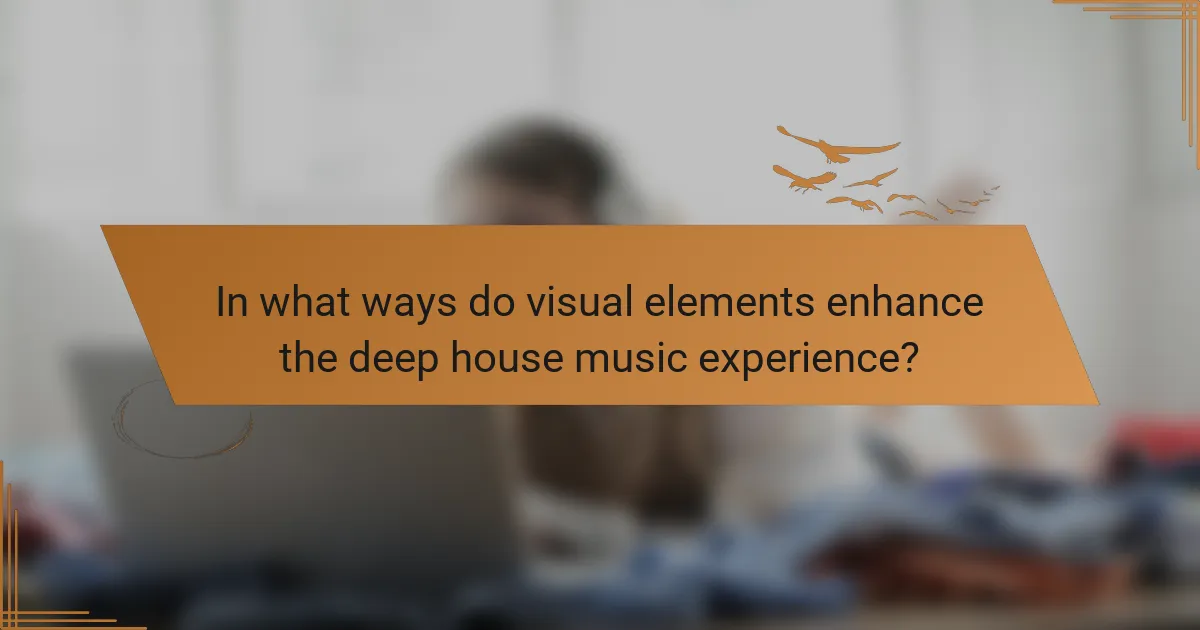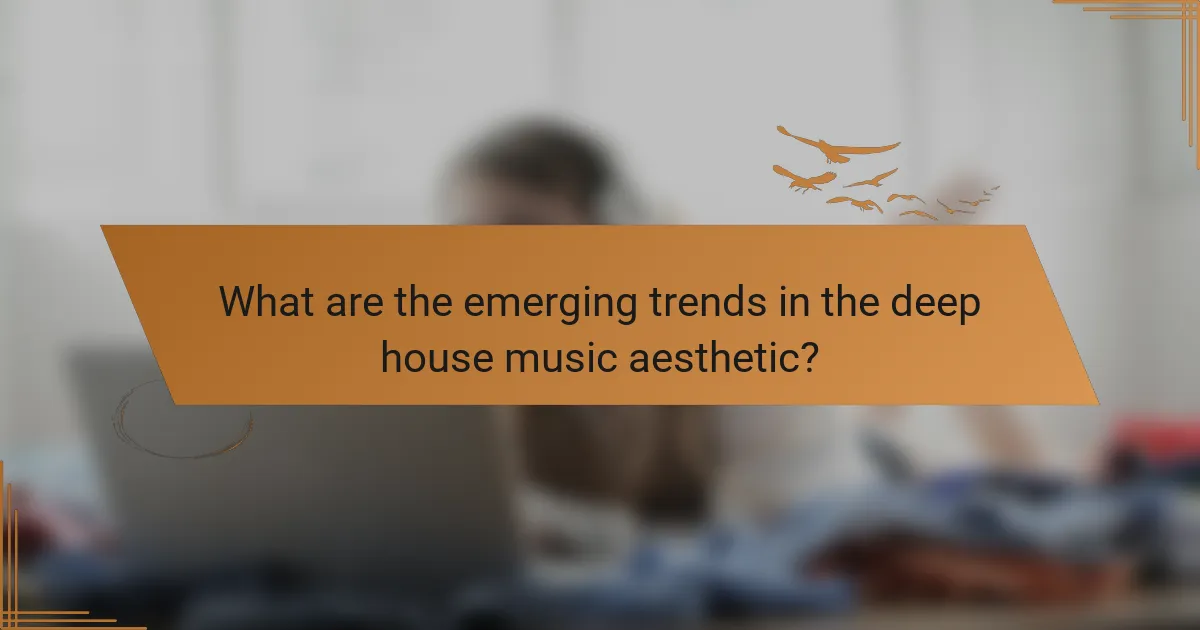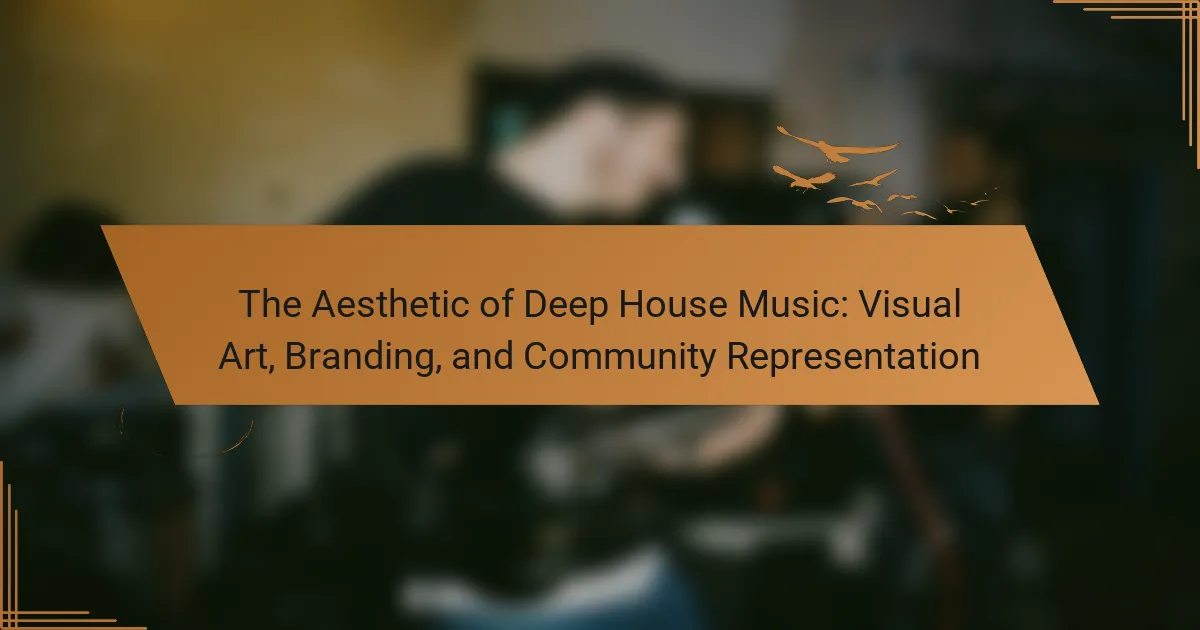Deep house music is characterized by its smooth, soulful sound, complex melodies, deep basslines, and emotive vocals, typically set within a tempo range of 120 to 125 BPM. This genre draws influences from jazz, funk, and soul, creating a rich auditory experience enhanced by ambient sounds and effects. The visual art associated with deep house features abstract designs and vibrant colors, reflecting the music’s emotional depth and community-oriented nature. Emerging trends focus on minimalism and organic sounds, with visual branding evolving to highlight diverse cultural influences and collaborations with visual artists. Overall, the aesthetic of deep house music intertwines auditory and visual elements to create an immersive experience that fosters community engagement.

What defines the aesthetic of deep house music?
Deep house music is defined by its smooth, soulful sound and complex melodies. It typically features deep basslines, atmospheric synths, and a slower tempo ranging from 120 to 125 BPM. Vocals in deep house are often soulful or jazzy, contributing to its emotive quality. The genre emphasizes a laid-back vibe, making it suitable for both dance floors and relaxed listening environments.
Deep house draws influences from jazz, funk, and soul music. This blend creates a rich, textured sound that resonates with listeners. The aesthetic is further enhanced by the use of ambient sounds and effects. These elements create an immersive auditory experience.
Visual art associated with deep house often reflects these qualities. Artwork typically features abstract designs, vibrant colors, and urban themes. This visual representation aligns with the music’s emotional depth and community-oriented nature.
In summary, the aesthetic of deep house music is characterized by its smooth sound, emotive vocals, and a strong connection to visual art and community culture.
How does visual art influence the deep house music aesthetic?
Visual art significantly influences the deep house music aesthetic by shaping its visual identity and emotional resonance. The vibrant colors and abstract forms in visual art reflect the genre’s rhythmic complexity and emotional depth. Artists often create album covers and promotional materials that visually represent the music’s mood. This visual representation enhances listener engagement and creates a cohesive brand image.
Moreover, visual art events, like exhibitions and installations, often accompany deep house music events, creating an immersive experience. The synergy between visual art and deep house fosters a sense of community among fans. This community is drawn together by shared experiences that blend auditory and visual stimuli.
Additionally, iconic visual artists, such as Keith Haring and Jean-Michel Basquiat, have inspired deep house aesthetics through their unique styles. Their influence can be seen in the graphic design elements used in promotional materials for deep house events. Overall, visual art enriches the deep house music aesthetic by providing context, enhancing emotional impact, and fostering community connections.
What are the common themes found in deep house visual art?
Common themes found in deep house visual art include abstract forms, vibrant colors, and urban landscapes. Abstract forms often represent the fluidity of music and emotions. Vibrant colors evoke energy and warmth, aligning with the genre’s uplifting nature. Urban landscapes reflect the cultural roots and community aspects of deep house. Additionally, themes of escapism and introspection are prevalent, capturing the immersive experience of deep house music. These visual elements create a cohesive aesthetic that resonates with the music’s vibe and its audience.
How do color palettes affect the perception of deep house music?
Color palettes significantly influence the perception of deep house music. The colors used in visual elements associated with this genre can evoke specific emotions and atmospheres. For instance, darker hues like deep blues and purples often create a sense of mystery and depth, aligning with the genre’s introspective nature. Conversely, vibrant colors like neon greens and pinks can energize and attract a younger audience, enhancing the party atmosphere typical in deep house settings. Research indicates that color psychology plays a critical role in how music is experienced. A study by Küller et al. (2009) demonstrated that colors can alter emotional responses to music. Thus, the choice of color palettes in branding and visuals for deep house music can shape listener expectations and overall engagement with the genre.
What role does branding play in the deep house music scene?
Branding plays a crucial role in the deep house music scene by shaping artist identity and fostering community engagement. It helps artists differentiate themselves in a crowded market. Effective branding creates a recognizable image that resonates with fans. This image often includes logos, visuals, and social media presence. Strong branding can attract collaborations and gigs, boosting an artist’s career. Additionally, labels use branding to establish a unique sound and aesthetic. This branding fosters a sense of belonging among fans. Ultimately, branding influences the overall perception and cultural significance of deep house music.
How do record labels establish their identity within deep house?
Record labels establish their identity within deep house through unique branding, artist selection, and visual aesthetics. They create a distinct brand image that resonates with the deep house community. This includes a specific logo, color palette, and design style that reflects the genre’s vibe. Additionally, labels curate a roster of artists who embody their sound and ethos. They often focus on developing long-term relationships with these artists to maintain a consistent musical identity. Promotional strategies, such as social media presence and event sponsorships, further reinforce their identity. Labels also engage with their audience through community-driven initiatives, enhancing their connection with fans. This multifaceted approach helps record labels carve out a recognizable identity in the competitive deep house landscape.
What are the key elements of effective branding in deep house music?
Effective branding in deep house music includes a strong visual identity, consistent messaging, and community engagement. A strong visual identity often features unique artwork and logos that resonate with the genre’s aesthetic. Consistent messaging ensures that promotional materials, social media, and artist communications align with the brand’s values. Community engagement fosters a loyal fan base through events, social media interaction, and collaboration with other artists. These elements create a recognizable brand that stands out in the competitive music market. Successful deep house brands often leverage platforms like SoundCloud and Instagram to connect with their audience.
How does community representation shape the deep house music aesthetic?
Community representation significantly shapes the deep house music aesthetic. It influences the genre’s sound, visuals, and cultural narratives. Diverse communities contribute unique musical styles and rhythms. This results in a rich tapestry of influences, from soulful vocals to intricate beats.
Visual art associated with deep house often reflects the backgrounds of its creators. This includes graphics, album art, and promotional materials. The aesthetic frequently showcases themes of inclusivity and unity. Events and festivals emphasize community engagement and shared experiences.
Historically, deep house emerged from urban centers like Chicago and New York. These locations were melting pots of culture and creativity. The representation of marginalized communities within the genre fosters authenticity. It also allows for storytelling that resonates with a broader audience.
Overall, community representation is essential in defining the deep house music aesthetic. It enriches the genre and ensures its evolution reflects the voices of those involved.
What are the cultural influences reflected in deep house music communities?
Deep house music communities reflect various cultural influences, including African American musical traditions and European electronic music. The genre draws heavily from disco, soul, and jazz, which originated in African American culture. This connection emphasizes rhythm, groove, and emotional expression.
Additionally, deep house incorporates elements from Chicago house and Detroit techno, showcasing its roots in the American Midwest. The genre also embraces global influences, integrating sounds from Latin, African, and Caribbean music.
Visual aesthetics in deep house often reflect urban culture, featuring artwork that captures nightlife and community. Events and festivals promote inclusivity, emphasizing diversity and unity among attendees.
The cultural influences are evident in the collaborative spirit of deep house music, where artists often work together across genres and backgrounds. This fusion creates a rich tapestry of sounds and experiences, reinforcing the community’s cultural significance.
How does community engagement enhance the deep house experience?
Community engagement enhances the deep house experience by fostering a sense of belonging among participants. This connection promotes shared enjoyment and collective participation in events. Engaged communities often create a vibrant atmosphere that amplifies the emotional impact of the music. Research indicates that social interactions during music events lead to increased satisfaction and memorable experiences. Additionally, community collaboration can influence the evolution of deep house music through shared ideas and creativity. This collaborative spirit not only enriches the musical landscape but also strengthens the ties between artists and their audience.

In what ways do visual elements enhance the deep house music experience?
Visual elements enhance the deep house music experience by creating an immersive atmosphere. They engage the audience’s senses beyond sound. Visuals can include light shows, projections, and artwork. These elements complement the rhythmic beats and melodies. Studies show that visuals can evoke emotions and enhance memory retention. Research indicates that synchronized visuals can increase audience engagement by up to 30%. This combination of audio and visual stimuli creates a holistic experience. Ultimately, visuals contribute to the overall vibe and aesthetic of deep house music events.
What types of visual art are commonly associated with deep house music?
Deep house music is commonly associated with abstract art, graphic design, and photography. Abstract art reflects the emotional depth and complexity of deep house music. Graphic design often includes vibrant colors and geometric shapes that resonate with the genre’s rhythmic beats. Photography captures the nightlife and community aspects of deep house culture. These visual art forms enhance the overall experience of deep house music events. They create a cohesive aesthetic that attracts fans and fosters community engagement.
How do music videos contribute to the deep house aesthetic?
Music videos contribute to the deep house aesthetic by visually representing its emotional and atmospheric qualities. They often feature abstract imagery that reflects the genre’s immersive soundscapes. This visual approach enhances the listener’s experience by creating a mood that aligns with the music. Additionally, music videos often showcase urban settings, which resonate with the genre’s roots in club culture. The use of vibrant colors and dynamic editing techniques further emphasizes the energetic yet relaxed nature of deep house. Iconic deep house tracks often have music videos that become synonymous with the songs, reinforcing their cultural significance. By integrating visual storytelling, these videos help to establish a deeper connection between the audience and the music.
What is the significance of album artwork in deep house music?
Album artwork in deep house music serves as a visual representation of the genre’s identity. It conveys the mood and themes of the music. The artwork often reflects the emotional depth and sophistication characteristic of deep house.
Visual aesthetics play a crucial role in attracting listeners. Engaging album covers can enhance the overall experience of the music. They can create a connection between the artist and the audience. Many deep house artists collaborate with visual artists to create unique designs.
This collaboration can lead to a distinctive brand identity. Iconic album artwork can become symbolic within the deep house community. It helps in establishing a sense of belonging among fans. Overall, album artwork is significant for branding, emotional connection, and community representation in deep house music.
How do visuals and music interact in deep house performances?
Visuals and music interact in deep house performances by creating an immersive sensory experience. The music sets the emotional tone, while visuals enhance the mood and atmosphere. Visual elements often include lighting, projections, and stage design. These visuals synchronize with the beats and rhythms of the music. This synchronization deepens audience engagement and enhances the overall experience. Research shows that combined sensory stimuli can lead to heightened emotional responses. For example, studies indicate that visual accompaniment can amplify feelings of euphoria during live music events. Thus, the interplay between visuals and music is essential in deep house performances for creating a cohesive and impactful atmosphere.
What role does lighting play in deep house music events?
Lighting plays a crucial role in deep house music events by enhancing the overall atmosphere. It helps create an immersive experience for attendees. The use of dynamic colors and patterns can influence emotions and energy levels. Lighting synchronizes with the beat and rhythm of the music, reinforcing the connection between sound and visual elements. Effective lighting design can also highlight performers, making them the focal point of the event. Studies show that well-executed lighting can increase audience engagement and satisfaction. In deep house events, lighting often reflects the genre’s aesthetic, contributing to a cohesive brand identity. Overall, lighting is essential for crafting memorable and impactful experiences in deep house music events.
How do visual projections enhance the audience’s experience?
Visual projections enhance the audience’s experience by creating immersive environments. They engage viewers through dynamic imagery that complements audio elements. This synergy amplifies emotional responses, making events more memorable. Research shows that visual stimuli can increase information retention by up to 65%. Projections also facilitate storytelling, allowing artists to convey deeper narratives. They transform physical spaces, making them visually captivating. This transformation fosters a sense of community among attendees. Overall, visual projections significantly elevate the overall atmosphere of events.

What are the emerging trends in the deep house music aesthetic?
Emerging trends in the deep house music aesthetic include a focus on minimalism and organic sounds. Artists are increasingly blending natural elements with electronic beats. This fusion creates a more immersive listening experience. Visual art associated with deep house is also evolving. Abstract and surreal visuals are becoming prominent in branding. Community representation is highlighted through diverse cultural influences. Collaborations with visual artists are common in music videos and promotional materials. This trend enhances the overall aesthetic and connects audiences. Social media platforms are amplifying these visual trends, making them more accessible.
How is technology influencing the visual representation of deep house music?
Technology is significantly influencing the visual representation of deep house music. Digital tools enable artists to create immersive visual experiences. Software like Adobe After Effects and Cinema 4D allows for intricate animations and graphics. High-quality visuals enhance live performances through projections and LED displays. Virtual reality (VR) and augmented reality (AR) are also being utilized for engaging audience experiences. Social media platforms facilitate the sharing of visual content, expanding reach and engagement. Data analytics tools help artists understand audience preferences for visuals. This integration of technology elevates the overall aesthetic of deep house music, creating a cohesive brand identity.
What innovative tools are artists using for visual art in deep house?
Artists in deep house are using digital tools like Adobe Creative Suite for graphic design. They also utilize 3D modeling software such as Blender for immersive visuals. Virtual reality platforms enable interactive art experiences. Projection mapping technology enhances live performances with dynamic visuals. Generative art tools create unique visual compositions in real-time. Hardware like MIDI controllers allows for hands-on manipulation of visual elements. These tools foster creativity and engagement in the deep house scene.
How do social media platforms shape the aesthetic of deep house music?
Social media platforms significantly shape the aesthetic of deep house music. They provide a space for artists to share visual content that reflects their musical style. Platforms like Instagram and TikTok allow for vibrant imagery and short videos that capture the mood of deep house. This visual representation often includes abstract art, urban landscapes, and nightlife scenes. The engagement metrics on these platforms influence trends in visual aesthetics. Artists adapt their imagery based on audience feedback and popular styles. Additionally, social media fosters a sense of community among fans and creators. This communal aspect encourages collaboration, further enriching the aesthetic landscape of deep house music.
What best practices can artists follow to create a cohesive deep house aesthetic?
Artists can create a cohesive deep house aesthetic by focusing on consistent visual elements. This includes using a specific color palette that resonates with the genre’s mood. Deep house often features earthy tones and soft pastels. Artists should also select typography that reflects the genre’s vibe, favoring clean and modern fonts. Incorporating abstract or minimalist designs in artwork can enhance the aesthetic.
Additionally, artists should maintain a consistent theme across their promotional materials. This includes social media graphics, album covers, and merchandise. Consistency helps in building a recognizable brand identity. Engaging with the community through visual storytelling is also essential. Artists can share their creative process and inspirations, fostering a deeper connection with their audience.
Collaborating with other artists in the genre can further strengthen the aesthetic. This often leads to a unified visual language that resonates with fans. Ultimately, a cohesive deep house aesthetic is achieved by aligning visual elements with the music’s emotional depth and community values.
How can collaboration with visual artists enhance the deep house music brand?
Collaboration with visual artists can significantly enhance the deep house music brand. This partnership allows for the creation of unique visual identities that resonate with the music’s aesthetic. Visual artists can produce album covers, promotional materials, and immersive visuals for live performances. These visuals help convey the mood and themes of deep house music, attracting a broader audience.
Research shows that cohesive branding, which includes visual elements, can increase audience engagement by up to 30%. Additionally, collaborations can lead to cross-promotion, where both the music and the art reach new fans. Notable examples include the use of innovative visuals in music videos that complement deep house tracks. This synergy not only strengthens brand identity but also fosters a sense of community among fans who appreciate both music and visual art.
What tips can help new artists establish their visual identity in deep house music?
New artists can establish their visual identity in deep house music by focusing on cohesive branding elements. This includes creating a unique logo that reflects their musical style. Artists should select a consistent color palette that resonates with deep house aesthetics. Utilizing specific typography can enhance their visual communication. Engaging with visual art forms, such as photography or graphic design, can further solidify their identity. Collaborating with visual artists can provide fresh perspectives and innovative designs. Additionally, maintaining a consistent presence across social media platforms is crucial for recognition. These strategies help in building a recognizable brand in the deep house community.
The primary entity of this article is deep house music, characterized by its smooth sound, emotive vocals, and intricate melodies. The article explores the aesthetic of deep house music, emphasizing the interplay between visual art, branding, and community representation. Key topics include the influence of visual art on the genre’s identity, the role of branding in artist differentiation, and the significance of community engagement in shaping deep house culture. Additionally, it examines emerging trends, technological impacts, and best practices for artists to establish a cohesive visual identity within the deep house scene.
